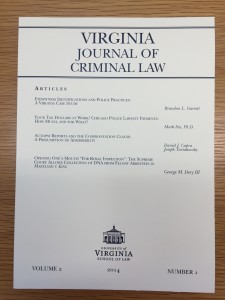 Date of Publication: Spring 2014
Date of Publication: Spring 2014
Articles:
Brandon L. Garrett, Eyewitness Identifications and Police Practices: A Virginia Case Study
Find on Westlaw
Abstract: Over three decades of social science research have powerfully shown that lineup procedures really matter and that eyewitness errors predictably result from substandard lineups. Yet traditionally, many police departments had no written policies at all on conducting photo arrays or lineups. In response, more police departments, prosecutors, state courts and legislatures have acted to improve identification procedures. Although much has changed in the past decade, less is known about how many police departments have not yet adopted best practices. This Essay reports the results of a 2013 survey conducted of lineup procedures in Virginia, where a new state model policy was adopted in 2011 in response to a series of DNA exonerations caused by eyewitness misidentifications, as well as concern with the slow pace of adoption of best practices. Of the 201 law enforcement agencies that responded, 144 supplied eyewitness identification policies. Troubling findings included that in total, only 29% required blind lineup procedures and only 40% made blind lineup procedures available even as an option. Only 6% adopted the revised model policy. The results suggest that institutional inertia, and not policy choices, explain the slow pace of adoption of best practices. As a result, dissemination of best practices by state policymakers may not be enough, and stronger regulatory measures may be required to safeguard the accuracy of criminal investigations.
Mark Iris, Ph.D., Your Tax Dollars at Work! Chicago Police Lawsuit Payments: How Much, and for What?
Find on Westlaw
Introduction: Lawsuits alleging wrongs committed by police officers are a fact of life. Verdicts and settlements similar to those noted above are paid out in major– and not so major–jurisdictions across the country. For police managers and other local officials, these lawsuits are significant for at least two very important reasons. First, each lawsuit clearly communicates that someone in the public is very dissatisfied, even outraged, with the perceived misconduct of the local police. Thus, a lawsuit represents some degree of failure of police-community relations, an erosion of public confidence in the police. Second, these lawsuits are a drain on local funds. The financial costs include not only monies paid to plaintiffs as the result of out of court settlements and trial verdict judgments, but also legal expenses. . . .
Daniel J. Capra and Joseph Tartakovsky, Autopsy Reports and the Confrontation Clause: A Presumption of Admissibility
Find on Westlaw
Abstract: Courts nationwide are divided over whether autopsy reports are “ “testimonial” under the Sixth Amendment’s Confrontation Clause. Resolving that split will affect medical examiners as dramatically as Miranda did police. This article applies the latest Supreme Court jurisprudence to the work of modern medical examiners in a comprehensive inquiry. It argues that autopsy reports should be presumed non-testimonial–a presumption overcome only by a showing that law enforcement involvement materially influenced the examiner’s autopsy report.
George M. Dery III, Opening One’s Mouth “For Royal Inspection”: The Supreme Court Allows Collection of DNA from Felony Arrestees in Maryland v. King
Find on Westlaw
Abstract: This article analyzes Maryland v. King, in which the Supreme Court considered whether the Fourth Amendment prohibited collection and analysis of a DNA sample from persons arrested on felony charges. The King Court ruled that when officers bring an arrestee of a serious offense to the station to be detained in custody, taking and testing a cheek swab of the arrestee’s DNA is reasonable under the Fourth Amendment. This work examines the concerns created by King‘s ruling. This article asserts that, in justifying suspicionless collection of DNA, King created a “misery loves company” rationale that undermined Fourth Amendment protections. Further, King failed to fairly balance all of the interests implicated in a DNA swab, sacrificing the privacy interests persons have in their own DNA. Finally, in straining to apply cases beyond their original purposes, King eroded the protections of the warrant requirement.